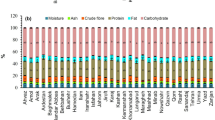Abstract
Reports on the nutritional composition of cowpea leaves have been limited to a small number of lines and the palatability characteristics of leaves apparently have not been studied. This study was therefore undertaken on cowpea leaves to determine the nutrient composition of fifteen varieties and the sensory attributes of ten varieties grown in Ghana. Nutritional components studied were moisture, protein, phosphorus and ascorbic acid. The sensory attributes included leaf size, taste and overall acceptability. There were significant (p > 0.05) differences among varieties in all nutrient components (fresh and dry weight basis), leaf size and overall acceptability. The nutrient composition values, on a dry weight basis, ranged from 9.4 to 13.0% for moisture, 303.8 to 468.9 mg/100 g for phosphorus, 33.5 to 148.0 mg/100 g for ascorbic acid, and 27.1 to 34.7% for protein. Differences in the sensory scores of leaves for taste were not significant (p < 0.05). Overall acceptability positively correlated with leaf size. Moisture content was negatively correlated with overall acceptability, phosphorus and ascorbic acid. Results can be exploited in a breeding program to develop nutritionally superior and acceptable cowpea varieties which can be used for harvesting of both leaves and seeds.
Similar content being viewed by others
References
Wien HC, Summerfield RJ (1984) Cowpea (Vigna unguiculata [L.]Walp). In: Goldsworthy PR, Fisher NM (eds), The physiology of tropical field crops. Chichester: John Wiley and Sons, pp 353–383.
Maeda EE (1985) Effect of solar dehydration on amino acid pattern and available lysine content in four tropical leafy vegetables. Ecology of Food and Nutrition 16: 273–279.
Duke JA (1981) Vigna unguiculata [L.] Walp. Ssp. unguiculata. In: Duke JA (ed), Legumes of world economic importance. New York: Plenum Press, pp 302–305.
Barret RP (1987) Integrating leaf and seed production strategies for cowpea (Vigna unguiculata [L.] Walp). MS Thesis. Michigan State University, East Lansing, MI, USA.
Barret RP (1990) Legume species as leafy vegetables. In: Janick J, Simon JE (eds),Advances in new crops. Portland, OR: Timber Press, pp 391–396.
Ohler TA, Nielsen SS, Mitchell CA (1996) Varying plant density and harvest time to optimize cowpea leaf yield and nutrient content. Hort Science 31(2): 193–197.
Bittenbender HC (1992) Handling and storage of cowpea Vigna unguiculata [L.] Walp as a leaf vegetable. Tropical Agric (Trinidad) 69: 197–199.
Nielsen SS, Ohler TA, Mitchell CA (1997) Cowpea leaves for human consumption:production, utilization, and nutrient composition. In: Singh BB, Mohan Raj DR, Dashiell KE, Jackai LEN (eds), Advances in cowpea research. Ibadan: Copublication of International Institute of Tropical Agriculture (IITA) and Japan International Research Center for Agriculture Sciences (JIRCAS), pp 326–332.
Imungi JK, Potter NN (1985) Nutritional and sensory properties of canned and stored cowpea leaves. Nutrition Reports Int 31: 21–34.
Leung WTW (1968) Food composition table for use in Africa. Rome, Italy: Food and Agriculture Organization.
Singh BB, Sharma B (1996) Restructuring cowpea for higher yield. Indian J Genet 56:389–405.
Ahenkora K, Adu-Dapaah H, Ansere-Bioh F, Asare S (1996). Participatory appraisal of dual purpose cowpeas development in Ghana. Food and Nutrition Discussion Paper. Crops Research Institute, Kumasi, Ghana.
Rowland JRJ (1992) Grain legumes. In: Rowland JRJ (ed), Dryland farming in Africa. Basingstoke, London: Macmillan, pp 260–284.
Benton Jones J Jr, Wolf B, Mills HA (1991) Plant Analysis Handbook. A practical, sampling, preparation, analysis, and interpretation guide. Athens, GA: Micro-Macro Publishing.
AOAC (1997) Official Methods of Analysis, 16th edn. Washington, DC: Association of Official Analytical Chemists.
Larmond E (1977) Laboratory methods for sensory evaluation of foods. Canada Department of Agriculture, Ottawa, Publication 1637.
Oomen HAPC, Grubben GJH (1977) Tropical leaf vegetable in human nutrition. Department of Agriculture, Koninklijk Institut voor de Tropen, Amsterdam, Netherlands, Research Communication 69.
NRC (1980). Recommended dietary allowances., 9th edn. Washington DC: National Research Council, National Academy of Science.
Author information
Authors and Affiliations
Rights and permissions
About this article
Cite this article
Ahenkora, K., Adu Dapaah, H. & Agyemang, A. Selected nutritional components and sensory attributes of cowpea (Vigna unguiculata [L.] Walp) leaves. Plant Foods Hum Nutr 52, 221–229 (1998). https://doi.org/10.1023/A:1008019113245
Issue Date:
DOI: https://doi.org/10.1023/A:1008019113245




